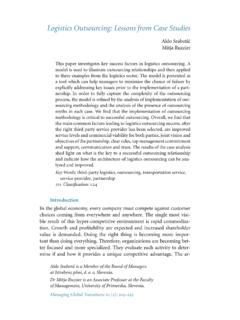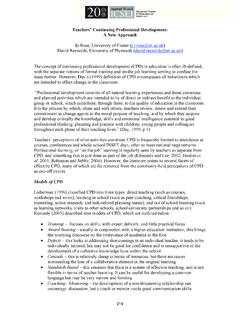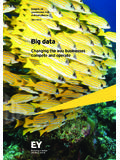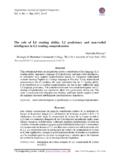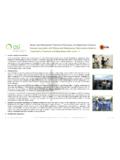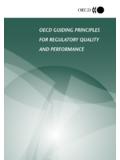Transcription of The Analysis of Organizational Culture and …
1 The Analysis of Organizational Culture and structure as a Basis for the Implementation of knowledge Management Erich Hartlieb, Marjan Leber, Josef Tuppinger, and Reinhard Willfort Innovation Service Network Austria In the commercial world of today knowledge Management and Organizational Learning are supposed to be indispensable prereq- uisites for the competitive ability of companies. Organizational learning can be considered analogous to individual learning. It is based on individual learning processes and means a change of Organizational structure and/or Culture with the aim of surviv- ing in the dynamic environment. Organizational learning should be systematic and should include all the people concerned. Man- agers, in particular, have the potential to change an organization and therefore they should act in an exemplary way.. Today's business is characterized by rapid technological developments, intensified terms of competition and self-changing values.
2 Organisations can only remain competitive in this dynamic field if they change. There- fore, a systematic interaction of both organisational learning and knowl- edge known as knowledge management has become an important matter for organisations. It seems that the existing structures and pre- vailing organisation cultures, in particular, have an essential influence on the success of these efforts. This article shows that organisational learn- ing can be undertaken in a deliberate way and that people play a leading part in this process. A case study illustrates and improves the theoretical comments and gives a lot of tips for real use.. knowledge psychology distinguishes between declarative and procedural knowledge . Whilst declarative knowledge refers to facts (issues, processes etc.) and objects (persons, things etc.), procedural knowledge refers to the way cognitive processes and actions are performed.
3 Declarative knowledge is also described as knowledge of something (knowing) or . Erich Hartlieb, Marjan Leber, Josef Tuppinger, and Reinhard Willfort Procedural learning Actions Perception Achievements Perception Procedural knowledge Organisational structure Declarative knowledge Organisational Culture Cognitive association Contextual association Standards and values Cultural interpretation Declarative learning rs Human rs Organisation Human/organisational learning model know-what'. Procedural knowledge is also described as process knowl- edge or know-how'. Procedural learning involves the perception of stimuli and the initia- tion of appropriate behaviour (action). The Analysis of prior experiences (contextual placement) and the development of behavioural guidelines (cognitive association) are known as declarative learning. However, this dichotomy should not be misinterpreted.
4 Both levels of learning (and types of knowledge ) are in fact activated by the learning process and in- teract with it, even if one of them assumes a more prominent role. A human learning model (fig. ) shows the learning process as a four- phase cycle, with different types of knowledge created in each phase. This new knowledge is the starting point and an object of the next learning activity. A comparison of the analogies between humans and organisations shows organisational structure as a procedural element and organisa- tional Culture as a declarative element in organisations. These analogies are based on the following assumptions: People use procedural knowledge (know-how) to interact with their environment through action. In comparison, organisations use ap- propriate structures (procedures, processes) to generate activities and interact with their environment.
5 Declarative knowledge (know-what) is the starting point for proce- The Analysis of Organizational Culture and structure dural knowledge and any subsequent actions taken by people. Cor- respondingly, Culture can be described as the declarative knowledge of an organisation, since it provides the meaning and guidelines for behaviour and thus forms the basis of all actions. Consequently, the organisational and the human learning processes follow comparable phases, whereby any changes in the organisational structure can be seen as procedural learning and changes in Culture as declarative learning. Although it is possible that one particular learning process will assume a more prominent role, in practice they will always interact. Individual learning processes form the starting point for organisa- tional learning. It is individual learning that provides the impetus for.
6 Organisational change. The implementation of such a change also re- quires individual learning processes, which can involve all members of the organisation or smaller groups, depending on the scope of the actual change. : . A general, three-step ( Analysis , design and development) sequential model can be applied to organisational learning. Once the impetus for organisational learning has been given, i. e. a need for organisational change recognised in reactions from the environment, the Analysis phase can begin. In this phase, goals should be defined and the actual situation ( structure and/or Culture ) should be established and processed. Any research methods used will depend strongly on the resources available and should consider content, human resources and economic factors. Questionnaires are a quick and easy way of establishing a general picture of the current climate, whilst semi-standardised interviews take a more detailed look at the interviewee's individual situation.
7 Observa- tion methods are used primarily to support and/or verify other research methods. The next stage in the design process is to define a desired target sit- uation, compare it with the actual situation and derive appropriate in- terventions from the results of this comparison. An appropriate strategy should now be defined to address these shortfalls. This will depend on the degree of deviation between the target and the actual situations and the urgency of any identified issues. The process then moves into the development stage, where any pro- posed interventions are implemented, i. e. suitable measures are devel- Erich Hartlieb, Marjan Leber, Josef Tuppinger, and Reinhard Willfort oped, introduced and evaluated to ascertain how effective they have been in reaching the goals set. The following dimensions and their characteristics can be used as the basis for the Analysis and design of the organisational structure : Specialisation (specialised generalised).
8 Coordination (impersonal personal). Configuration (hierarchical heterarchical). Delegation of decisions (centralised decentralised). Formalisation (bureaucratic unbureaucratic). According to Edgar Schein the Analysis and design of the organisa- tional Culture can be based on elements of corporate Culture . These in- clude views on and attitudes to: Environment (threat opportunity). Reality (facts creativity). Human nature (independent dependent). Human action (control trust). Interpersonal relationships (competition cooperation). Graphical representations are an excellent way of presenting the re- sults of the situational Analysis and/or a target/actual comparison since managers often think and act in numbers' and show greater interest in dealing with any shortfalls presented to them in this form. Due to their communication capabilities and greater knowledge , managers were given the role of opinion leaders and upholders of the organisational cul- ture, which is essential for an effective and efficient change in the orga- nization.
9 : . This case study describes the application of the model in an automotive enterprise. The observed organization has been focusing on knowledge management for years. A project team was established to institution- alise this topic in the organisation. The team started some small pilot projects. Their first experiences showed that the members of the organi- zation were not very willing to cooperate. This condition could be due to several points: low acceptance of foreign' knowledge (the so-called not invented here' syndrome), The Analysis of Organizational Culture and structure lack of consciousness of the importance of the member's own knowledge for the organisation, little identification with work and lack of motivation for the real- ization of ideas, the necessary technical facilities ( & technology) were not avail- able and/or used incorrectly. As in many knowledge management projects, some symptoms could be traced back to organisational Culture .
10 To ensure that future efforts in the area of knowledge management were more effective, the team first decided to analyse the Culture and introduce appropriate measures for a knowledge management-oriented Culture . The tasks defined for this . project were therefore: To describe and evaluate the organisational Culture To point out problems and weaknesses To derive and conceive measures The superordinated goal of this project was to increase the acceptance of knowledge management and intensify the willingness to cooperate with this area. The approach used in this project was similar to the gen- eral procedural model. Culture Analysis The partial goals of the Analysis were to describe and prepare the current Culture using justifiable' resources. The following methods were used to describe the current Culture : Written questioning questionnaire Verbal questioning interview Participation observation The description of the current Culture was made according to the model based on basic underlying assumptions.





